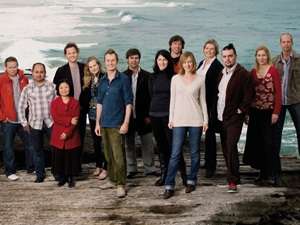|
Back
The Quiet Marriage of Poet and Composer New York
Zankel Hall, Carnegie Hall
04/30/2012 -
Anton Webern: Five Pieces for Strings, Op. 5
George Crumb: four movements from Black Angels
Maria Schneider: Winter Morning Walks (New York Premiere)Robert Schumann: Mondnacht, Op. 39, No. 5 (arr Jordan)
Franz Schubert: Geheimes, D. 719 (arr. Brahms) – Der Tod und das Mädchen, D. 810 (arr Tognetti)
Edvard Grieg: String Quartet in G Minor, Opus 27 (arr Tognetti)
Dawn Upshaw (soprano), Scott Robinson (clarinet), Ali Yazdanfar (bass), Frank Kimbrough (piano)
Australian Chamber Orchestra, Richard Tognetti (lead violin, artistic director)

Australian Chamber Orchestra (© Courtesy of the Artists)
Confined to a sparsely populated, predominantly scrubland atoll near the bottom of the planet, hounded by fierce koala bears and the sinister wallaby, it comes as no surprise that, even after 37 years, the Australian Chamber Orchestra has no idea about the protocol of Manhattan music-making.
How dare they begin a concert by layering an American Crumb cake with an filling of Austrian Webern? What gives their Music Director the right to orchestrate perfectly decent Schubert and Schumann lieder, or turning a Grieg string quartet into a string symphony?
Well, what about this right? That for almost four decades, the ACO has enlisted the finest string players from their little country (Australia’s motto: "Hic sunt dracones") transforming them into an ensemble that can easily rival our own Orpheus Chamber Orchestra. The de facto reality is that, like the Orpheus, they have no conductor. The esteemed Richard Tognetti–virtuoso violinist, composer, arranger, the man who taught Russell Crowe to handle a fiddle in a movie–acts more like a concertmaster. He stands with his 17-person orchestra, gives the downbeat and plays his Guarneri del Gesù with aplomb, élan and other words not usually associated with Australia.
It was, to be honest, a program of extraordinary imagination. One cannot think of any two composers more dissimlar than George Crumb and Anton Webern. Yet here was an experiment which not even the Kronos could imagine. Each of the tiny Five movements was followed by an excerpt from Crumb’s Black Angels. The first was pure string quartet writing–in this case amplified into a full string orchestra. That was early Webern. Early Crumb was also for string quartet, as well as percussion, bangs, whistles and an aura of the mysterious, of Good Versus Evil.
The idea was to make Webern “more romantic”. I honestly don’t think the experiment succeeded. While both composers could explain their music through numbers (or in Crumb’s case, through numerology), Webern was mathematically pure, the thin-rimmed physicist creating equations. Crumb has always been musically extrovert, creating worlds of horror and mystery, so vividly emotional that one cannot give a name to the emotions.
The result was to make Webern less astringent, and Crumb less viscerally painful. That is not a success.
This opening, though, introduced what I believe to be one of the most sheerly evocative and beautiful and memorable works for singer and orchestra that I have heard in years.
Maria Schneider has balanced a life of jazz and “serious” music, with her musical ensemble, and her compositions have won critical acclaim. Here, she was joined, in a sense, by a Poet Laureate Ted Kosser–like Ms. Schneider an artist from the rural Midwest, who, like Ms. Schneider, has an affinity for avian things, and who has a poetic sensitivity which should defy any composer.
The only collaboration like this in my memory is James Agee and Samuel Barber in Knoxville: Summer of 1917. Agee was a part-time poet, though, and Barber was a seriously trained composer. Mr. Kooser’s poetic sensibility in nine of these poems has a complex vision disguised by a naive series of walks in the woods. Ms. Schneider, was taught by a woman who was “equally at home with Mozart and Fats Waller”, and this music, which at times hinted at improvisation (the ACO added piano, clarinet and bass) developed a nocturnal background for the poems.

D. Upshaw (© IMG Artists)
The singer was Dawn Upshaw, whose soprano can take on the most eclectic guises. Here, she could sing, against a lush background about light and strarlight and birds in a barn….or the poet going on the road with a flashlight, “Coyote, racoon. Field mouse, sparrow, each watching from darkness, the man with the moon on a leash.”
Ms. Schneider’s music rocked softly as finches were rocking on a bird-feeder, it softly moaned to the couple “asking for thirty more years.” And in a piece starting with soft 1940’s near-jazz clarinet riff, the final statement by the poet of the importance “to someone that I am alive and walking….”
How I wish I could print all the poems and listen again to Ms. Upshaw singing. Being moved is rare, being moved so gently and so devotedly is simply a special occurrence. Messrs Kooser, Schneider and Upshaw deserve not my poor words, but some kind of bird-chirping orison.
For the second half, Ms. Upshaw sung Schubert and Schumann with string background, and the ACO finished with Mr. Tognetti’s arrangement of Grieg’s String Quartet. I suppose it worked. The ACO strings were lyrical and broad, the dances were jumping, and the Norwegian open harmonies were jolting, I applauded their efforts (and of course their prowess), but Grieg simply didn’t have the emotional pull of that exciting–and eccentric– first half.
Harry Rolnick
|